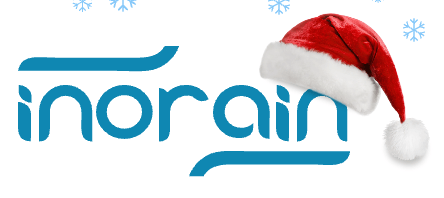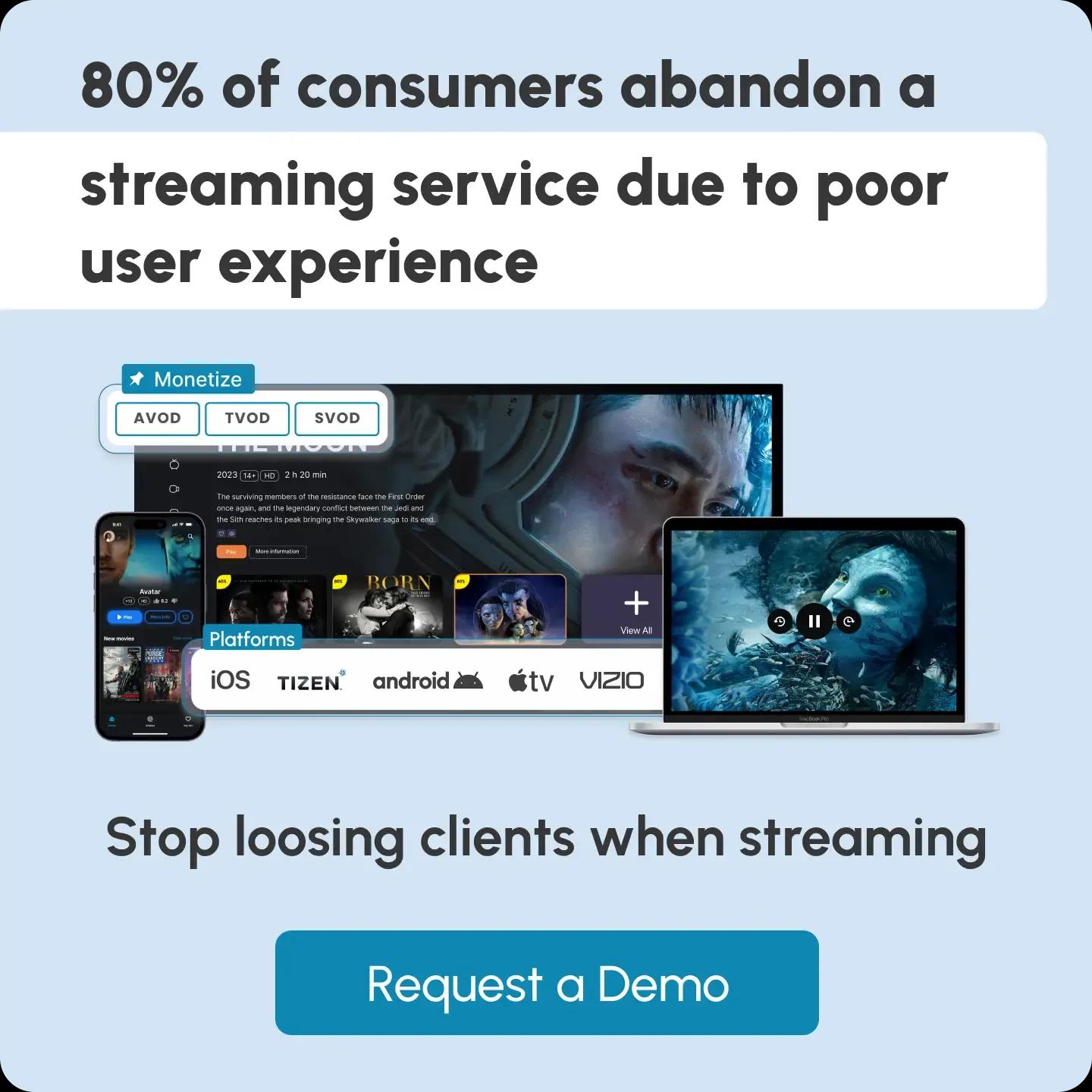
What is HDS Streaming? A Guide to HTTP Dynamic Streaming
HDS streaming (HTTP Dynamic Streaming) is a powerful protocol that enables the efficient delivery of high-quality streams to users across various devices.
HDS streaming is designed to adapt to varying network conditions. In general, streaming protocols such as HDS, MPEG-DASH, and HLS provide the building blocks for modern video content distribution.
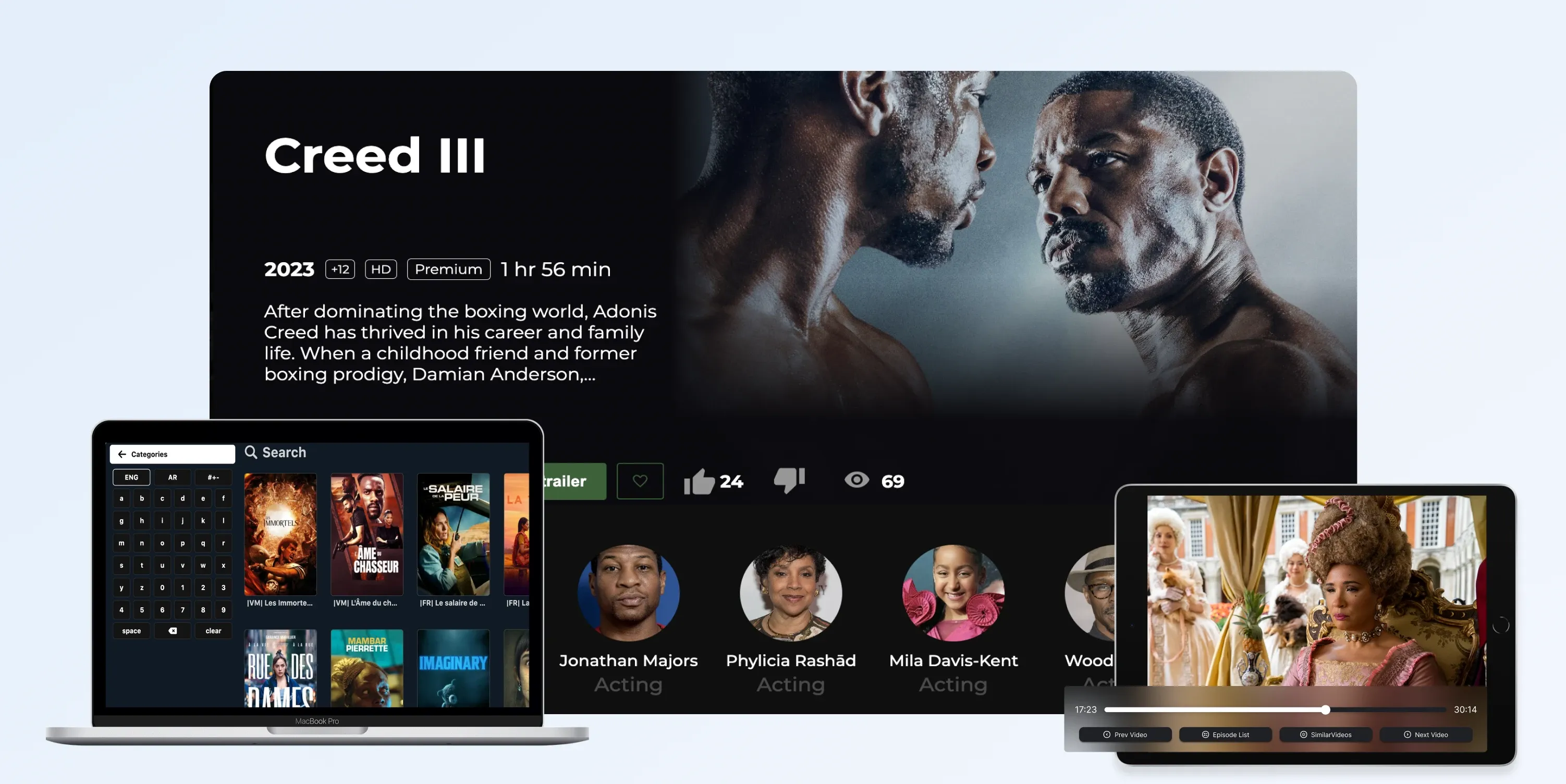 These protocols are critical for effectively delivering high-quality video to users across a range of devices, regardless of network conditions.
These protocols are critical for effectively delivering high-quality video to users across a range of devices, regardless of network conditions.
This article explores streaming protocols, the role HDS streaming played in shaping them, use cases, limitations, benefits, and how HDS compares to the standards that dominate today’s market.
Key Takeaways
- Adobe's HTTP dynamic streaming (HDS) was designed to optimize video content delivery over the internet, reducing costs while increasing playback quality.
- While HDS streaming was a great method for video streaming and paved the road for modern streaming protocols, it didn’t improve over time and has fallen out of use in favor of newer streaming protocols.
- Modern streaming protocols, such as HTTP Live Streaming (HLS) and MPEG-DASH, offer distinct benefits and features that are not available to systems still relying on HDS.
What is HDS Streaming?
HDS streaming (HTTP dynamic streaming) is a protocol developed by Adobe to deliver video content efficiently over the Internet. It uses adaptive bitrate streaming technology to dynamically adjust video quality based on the viewer's internet speed and device capabilities, ensuring smooth playback even on fluctuating networks.
The HDS streaming protocol was designed to work seamlessly with Adobe Flash Player, which was once the most popular platform for embedded video streaming.
Although no longer widely used or supported due to the discontinuation of Flash Player in 2020, HDS played a critical role in advancing adaptive streaming technologies. It also influenced the development of modern streaming protocols.
Historical Context: The Role of HDS in Adaptive Streaming
Adaptive streaming was first introduced in the early 2000s. It revolutionized the way video was delivered online. Before adaptive streaming, video quality was static, and playback would often buffer on the slower networks at the time.
Adaptive streaming introduced the ability to adjust video quality dynamically based on the user's bandwidth and device performance. It quickly became the industry standard, and as more companies adopted it, many new implementations arose to address specific use cases and limitations.
These include:
- Dynamic Adaptive Streaming over HTTP (DASH)
- Apple HTTP Live Streaming (HLS)
- Microsoft Smooth Streaming (MSS)
- Adobe HTTP dynamic streaming (HDS)
The Decline of HDS and Its Enduring Legacy
HTTP dynamic streaming was developed by Adobe to integrate with the Adobe Flash Player, which was, at the time, the most widely used embedded video player in the world.
However, like many other adaptive streaming options of the time, its dependence on a single platform would lead to its eventual discontinuation. Flash Player was discontinued in 2020 due to an abundance of security vulnerabilities, and better methods for embedding video were introduced that didn't rely on proprietary software or services.
HDS left a lasting mark on the streaming industry. Elements of its design, such as efficient metadata handling and adaptive bitrate delivery, influenced modern protocols like MPEG-DASH. While HDS streaming is no longer a part of contemporary video delivery, its innovations helped shape the adaptive streaming technologies we rely on today.
How HDS Streaming Works
Adobe's HTTP dynamic streaming (HDS) was designed to optimize video content delivery over the internet, reducing costs while increasing playback quality.
Three core processes enable this: Fragmentation, Manifest Files, and Adaptive Bitrate Delivery.
 Let’s look at these processes in more detail:
Let’s look at these processes in more detail:
Fragmentation
The HDS streaming protocol divides video files into smaller units called fragments. These fragments are typically a few seconds long and form the foundation for adaptive streaming. They enable the video player to handle video delivery in smaller pieces.
Each fragment is encoded and stored separately, allowing the video player to dynamically request and play specific pieces based on the current bandwidth and device performance.
The length of the fragments depends on the use case. For example, live streaming often uses smaller fragments to reduce delays, while on-demand sites use larger fragments to increase efficiency.
To further optimize video delivery, fragments can be grouped into segments. Segments represent a continuous list of fragments. Using segments reduces the number of individual files that need to be handled by the video player and the content delivery network (CDN), making content delivery faster and reducing server overhead for the content provider.
Manifest Files
Manifest files are XML files that contain all the metadata required by the video player. This metadata is crucial for enabling adaptive bitrate streaming. Key information contained in the manifest file includes:
- Content Metadata: Contains information about the video, such as duration, language, resolution, etc.
- Segment Index Data: All the segment- and fragment-related data needed to reference and retrieve specific parts of the video.
- Content Protection Metadata: If applicable, manifest files can contain content protection metadata used for digital rights management and encryption.
Manifest files are what enable the video player to understand the video structure and to receive the necessary fragments needed by the user.
Adaptive Bitrate Streaming
Adaptive bitrate streaming is a streaming technique that dynamically adjusts video quality during playback based on the user’s available bandwidth, device capabilities, and processing power. This ensures smooth playback with minimal buffering, even under fluctuating network conditions.
Adaptive bitrate streaming operates by storing segment indexes in a manifest file (an M3U8 file for HLS or an MPD file for MPEG-DASH). Each segment has multiple renditions, which are versions of the duplicate content encoded at different bitrates and resolutions. For instance, one segment may be available in 1080p, 720p, and 480p quality.
During playback, the video player evaluates the user's current network conditions and device performance. It selects the most appropriate rendition of each segment to optimize the viewing experience, seamlessly switching between renditions as conditions change.
6 Benefits of HDS Streaming
While HDS streaming has largely been replaced by modern, platform-independent protocols like HLS and MPEG-DASH, it still offers valuable benefits in specific scenarios. Here’s a closer look at why HDS remains relevant for specific use cases:
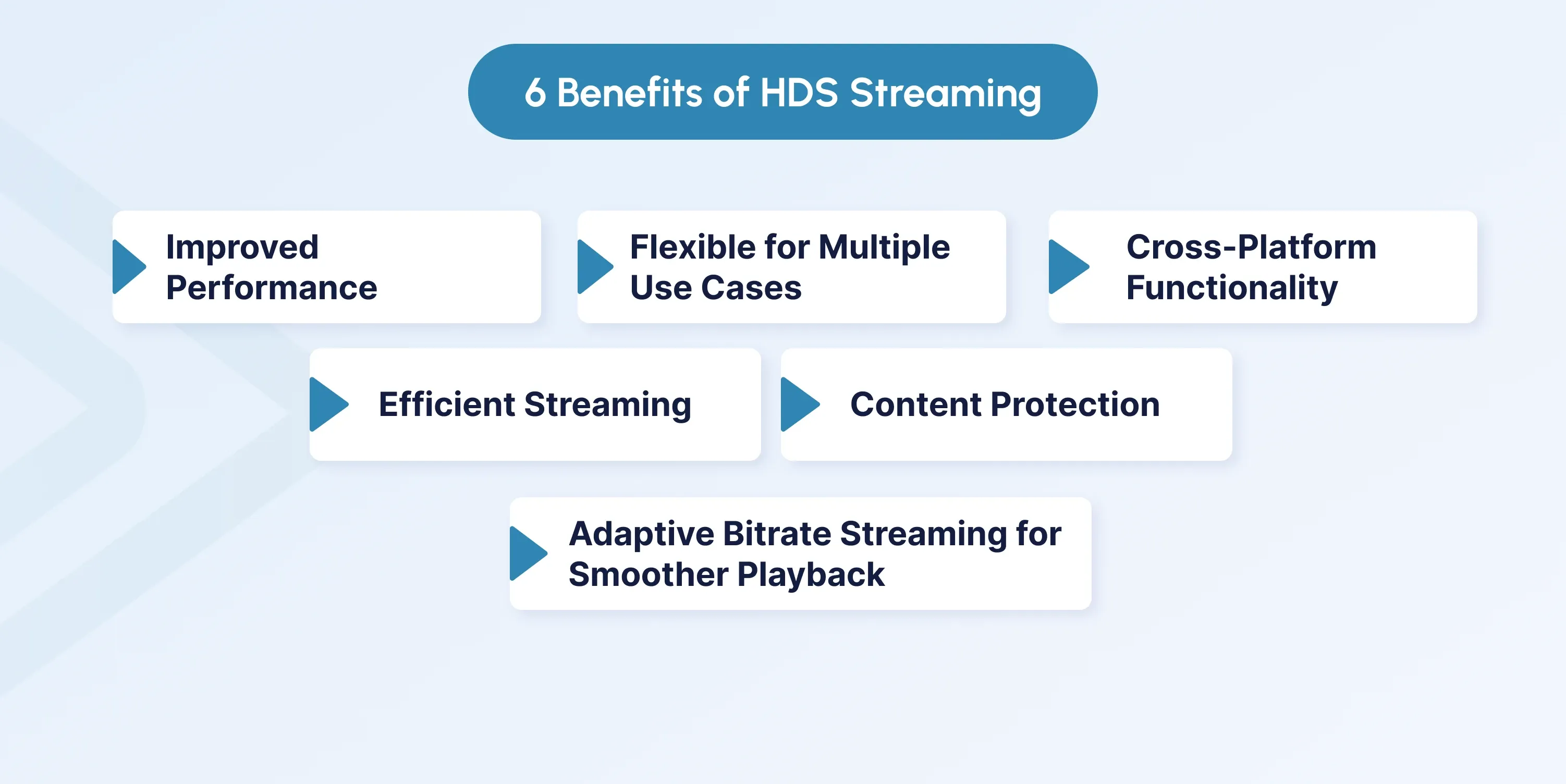
1. Adaptive Bitrate Streaming for Smoother Playback
HDS streaming allows users to watch real-time video content in different qualities, depending on their current network and device performance. This ensures a smoother streaming experience even on slower networks.
2. Flexible for Multiple Use Cases
HDS segment and fragment sizes can be adjusted depending on the use case. For example, on-demand video content sites typically use longer fragments and segments to optimize processing overhead. Live streaming websites typically use shorter fragments and segments to reduce live stream delay.
3. Efficient Streaming
HDS streaming optimizes video delivery by utilizing segment indexes. These indexes help minimize streaming overhead by fetching only the required video fragments. This process ensures the best possible quality for the viewer, taking into account their network speed, without wasting bandwidth.
4. Cross-Platform Functionality
HDS uses HTTP for video delivery, which allows it to remain functional on a wide range of platforms, even after the discontinuation of Adobe Flash. This makes HDS particularly useful in environments where Flash is no longer supported, but the underlying HTTP-based technology remains in use.
5. Content Protection
HDS supports DRM (Digital Rights Management) through metadata embedded in manifest files. This helps secure video streams and prevent unauthorized redistribution, making HDS suitable for protected or premium content delivery.
6. Improved Performance with HTTP
Content delivery networks can use HTTP caching to store frequently accessed segments on servers separate from the main content server. This can significantly reduce the server load and provide users with faster access to video content through servers closer to their location.
Limitations of HDS Streaming
HTTP dynamic streaming was a great method for video streaming and paved the way for modern streaming protocols. However, HDS didn’t improve over time and has since fallen out of use in favor of newer streaming protocols.
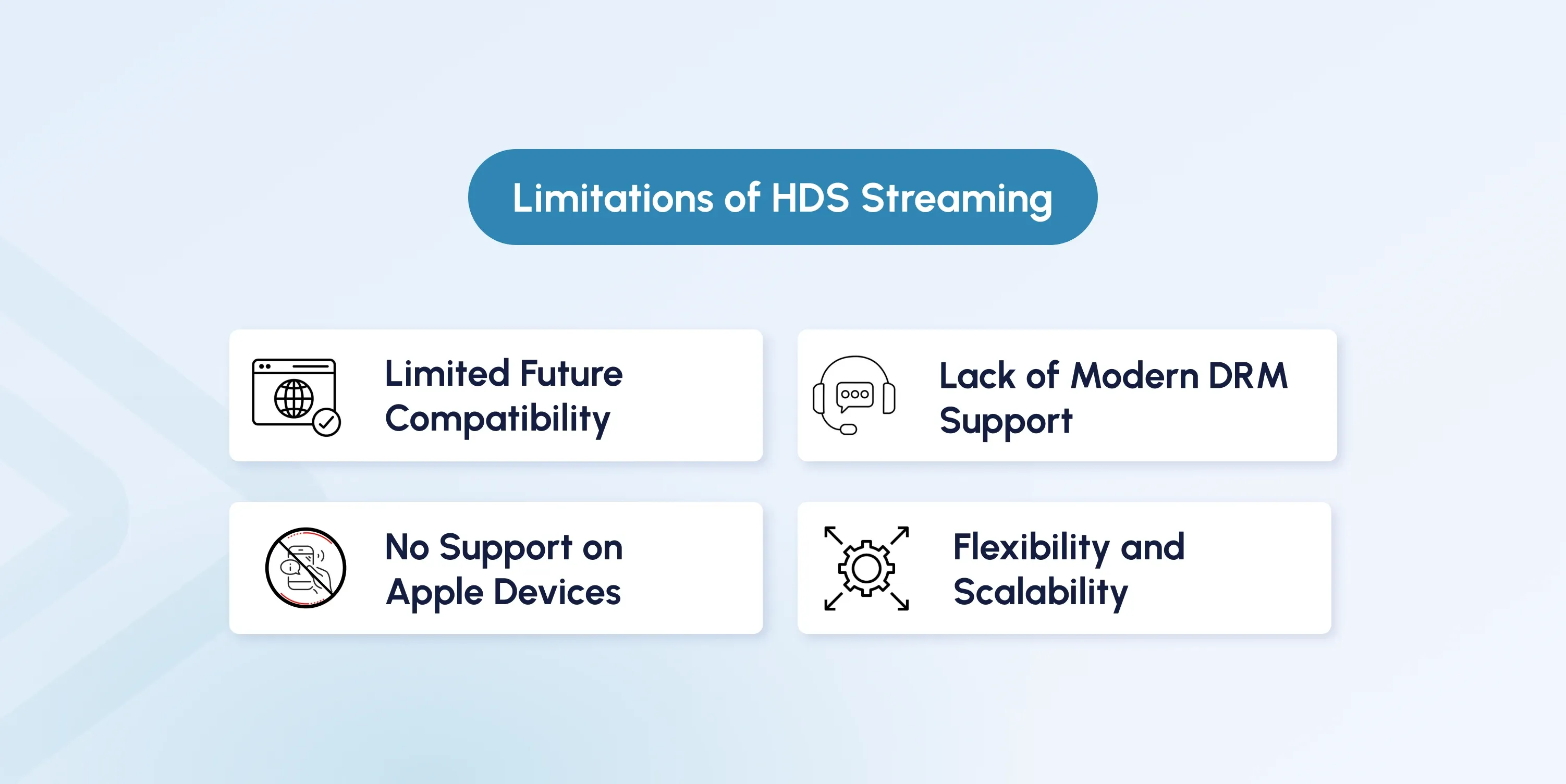
Limited Future Compatibility
Due to the deprecation of Adobe Flash and its support being dropped by modern browsers, the usage of HDS will likely remain on legacy systems that still rely on Flash.
No Support on Apple Devices
From the outset, Apple devices didn’t support HDS, as Apple focused on its own HTTP Live Streaming (HLS) protocol. HLS eventually became an open standard, gaining widespread adoption across devices and platforms. Meanwhile, Adobe ceased updating HDS, allowing HLS to dominate the streaming landscape, especially on Apple devices.
Flexibility and Scalability
Although the HDS streaming protocol offered notable efficiency and flexibility during its peak in the 2000s, it falls short compared to modern streaming protocols. Newer options like HLS and MPEG-DASH are designed to meet the demands of today’s video content distribution, including higher resolutions and support for advanced web technologies.
HDS’s reliance on Flash limits its ability to integrate with these innovations, making it an impractical choice for scalable, future-ready video delivery.
HDS vs. Modern Streaming Protocols
The lack of updates to Adobe's HTTP dynamic streaming protocol has left it far behind in terms of general features.
Modern video streaming protocols such as HTTP live streaming (HLS) and MPEG-DASH (dynamic adaptive streaming over HTTP) offer distinct benefits and features that aren’t available to systems still relying on HDS.
Here is a table showing how HDS differs from modern streaming protocols:
| Feature | HDS (HTTP Dynamic Streaming) | Modern Protocols (HLS and MPEG-DASH) |
|---|---|---|
| Platform Compatibility | Relies on Adobe Flash, which is deprecated and unsupported by most modern browsers. Limited compatibility with current devices and browsers. | Widely supported across modern devices and platforms, including smartphones, tablets, desktops, smart TVs, and gaming consoles. |
| Adaptive Bitrate Streaming | Offers basic adaptive streaming capabilities but lacks efficiency compared to modern standards. | Provides efficient adaptive bitrate streaming, dynamically adjusting video quality based on network conditions for smoother playback. |
| Content Security and DRM Support | Limited support for modern encryption methods and DRM tools. Lacks advanced security features. | Supports advanced encryption (e.g., AES-128) and DRM solutions like Widevine and PlayReady, ensuring secure content delivery. |
| CDN Efficiency | Utilizes HTTP for content delivery but is less efficient, leading to slower streaming and higher server load. | Designed for efficient CDN integration, enabling scalable and fast content delivery with reduced latency and buffering. |
| Future Viability | Obsolete due to reliance on deprecated Flash technology. Usage is confined to legacy systems. | Actively maintained and widely adopted, ensuring compatibility with current and future streaming environments. |
Use Cases for HDS Streaming
Due to the discontinuation of Adobe's Flash Player and the lack of modern features offered by other streaming protocols, the use cases for HDS in 2025 are confined mainly to legacy systems and tools that still rely on Flash or HDS in some way.
HDS still serves specific purposes in certain environments. Here are the primary use cases where HDS streaming remains relevant:
Legacy Systems and Applications
HDS is still a viable option for organizations that rely on legacy systems supporting Adobe Flash. These setups, often used in older corporate networks or educational platforms, benefit from HDS’s compatibility with pre-existing infrastructure.
Migrating from HDS to newer protocols may require a significant investment, so some systems continue to use HDS streaming for cost efficiency.
On-Demand Video Archives
Platforms or services hosting older video libraries encoded in HDS can continue to deliver content efficiently to users with compatible devices. Since HDS supports adaptive bitrate streaming and efficient segment delivery, it can handle archived on-demand content without significant re-encoding.
Internal Networks and Closed Systems
In closed or controlled environments where modern browser support isn’t a concern, HDS streaming remains a practical option. Examples include internal training systems, corporate video distribution, or private networks where the controlled ecosystem mitigates the limitations of Flash.
Integration with Proprietary Software
Some proprietary systems and applications built during HDS’s peak may still depend on its capabilities. In scenarios where these applications remain in use, HDS can be a straightforward and familiar solution for streaming video.
Use in Specific Geographic Regions
HDS may still be used in regions where infrastructure upgrades are slow and older technologies, like Flash, are still in use. In such cases, HDS streaming can serve as a stopgap for video delivery until newer protocols are adopted.
Although HDS is no longer widely supported, it still has niche use cases in legacy systems, on-demand archives, and closed networks.
That said, the world is transitioning to online and OTT streaming platforms that require large, scalable, and adaptable systems to succeed. The HDS streaming protocol doesn’t offer the broad reach that modern protocols do, and the declining support for Flash creates practical challenges for maintaining these systems.
Newer protocols such as HLS and MPEG-DASH offer much broader compatibility with HTML5 and support more advanced adaptive bitrate streaming on multiple devices. For companies looking to reach a wider audience with their content, transitioning to a modern streaming solution—like those provided by inoRain, is essential for future growth.
7 Steps to Transition from HDS to Modern Protocols
As HTTP Dynamic Streaming (HDS) becomes increasingly obsolete due to limited browser support, transitioning to modern protocols like HLS (HTTP Live Streaming) or MPEG-DASH is essential for keeping up with evolving streaming standards.
Here’s how to approach this transition effectively:
Step 1: Evaluate Current Infrastructure
Before transitioning, assess your existing infrastructure to determine compatibility with modern protocols. Identify systems, software, and workflows that rely on the HDS streaming protocol. This evaluation will help you understand the scope of changes required, such as upgrading encoding tools, storage configurations, and content delivery mechanisms.
Step 2: Re-Encode Video Content
HDS content is typically stored in formats compatible with Adobe Flash. To migrate, video libraries may need to be re-encoded into formats supported by modern protocols. Both HLS and MPEG-DASH support adaptive bitrate streaming and can handle high-quality video, making them ideal for future-proofing your content.
Step 3: Implement a Multi-Protocol Approach
During the transition, it can be helpful to implement a multi-protocol streaming strategy. By simultaneously offering HDS, HLS, and MPEG-DASH, you can ensure compatibility with older systems while introducing support for modern devices and browsers. This approach minimizes service disruptions and allows for gradual adoption.
Step 4: Use Cloud-Based Encoding and Delivery
Cloud-based solutions offer scalable tools for transitioning away from HDS. Many content delivery networks (CDNs) provide built-in support for HLS and MPEG-DASH, as well as tools for re-encoding content, managing adaptive streams, and distributing video to global audiences. Using these services can make the transition process simpler.
Step 5: Integrate Advanced Features
Modern protocols provide opportunities to enhance your streaming capabilities:
- HLS: Supported by most devices, especially Apple products, and provides excellent cross-platform compatibility.
- MPEG-DASH: Offers codec flexibility and superior scalability, making it a strong choice for high-quality content and on-demand services.
- DRM Support: Modern protocols integrate advanced DRM systems like Widevine and PlayReady for improved content protection.
Step 6: Train Your Team
Ensure your technical team is trained to manage and operate the new protocols. Modern streaming workflows may involve new tools, encoding settings, and monitoring systems that differ significantly from those used with HDS.
Step 7: Test the Transition
Test streams using modern protocols to identify and resolve any potential issues before fully migrating. Testing ensures compatibility with devices, browsers, and networks, providing a seamless user experience.
Use Modern Streaming Technologies with inoRain
With over 20 years of expertise in video content distribution, inoRain can help you transition from the HDS streaming protocol to modern streaming technologies. Our team offers expert support and fully customized solutions, ensuring a smooth transition to advanced streaming methods that meet the specific needs of each client.
inoRain specializes in building and optimizing OTT platforms, the modern alternative to traditional media services like satellite and cable TV.
We offer:
- Diverse Monetization Options: Unlock revenue through ads, subscriptions, pay-per-view, and other flexible monetization models.
- High-Quality Video Streaming: Seamless integration with top-tier CDNs ensures fast, reliable, and high-definition streaming.
- Advanced DRM Protection: Robust digital rights management safeguards your content from unauthorized distribution.
- Support for Modern and Future Devices: Built with cutting-edge technology, inoRain’s white-label OTT platforms are compatible with current and emerging devices.
- In-Depth Analytics Dashboard: Track performance, monitor key metrics, and make data-driven decisions using our advanced analytics tools.
- Custom Branding: Personalize your platform with custom logos, themes, and other design elements to reflect your company’s identity.
- 24/7 Support: Our dedicated team is available around the clock to resolve issues quickly, ensuring uninterrupted service.
Whether you're launching an OTT platform for the first time or upgrading an existing one, inoRain is here to help you succeed. Don’t hesitate, contact us to get your white-label OTT platform today.
Conclusion
As legacy systems like the HDS streaming protocol fade into disuse, the shift to modern protocols such as HLS and MPEG-DASH becomes essential. These advanced solutions provide the scalability, security, and compatibility needed to thrive in today’s fast-paced digital landscape, where audience expectations and technology are constantly evolving.
For platforms still relying on HDS, making the transition to a modern protocol unlocks numerous benefits, including improved performance, broader audience reach, and future-proofed content delivery systems.
FAQs
What is HDS?
HTTP Dynamic Streaming (HDS) is a streaming protocol developed by Adobe. It delivers video content over the internet using standard HTTP connections. HDS allows video quality to adjust dynamically based on the viewer's network conditions and device capabilities.
Is HDS out of use?
Although some legacy systems still rely on HDS, the streaming protocol is no longer widely used due to its incompatibility with modern technologies.
Why is HDS being replaced by modern protocols like HLS and MPEG-DASH?
Adobe developed HDS to work with Adobe Flash. This requirement, alongside outdated features and numerous security vulnerabilities found in Flash, has led to a general decline in the usage of HDS streaming. Modern protocols like HLS and MPEG-DASH offer access to newer tools and better content security methods, to name just a few of the benefits.
What is the role of manifest files (F4M) in HDS streaming?
Manifest files store metadata about a video. This metadata includes different quality levels, called renditions and segment indexes, to support multiple quality levels on different devices as needed.
How does inoRain support platforms using HDS?
inoRain provides expert assistance to platforms still using HDS streaming, helping them transition seamlessly to modern streaming protocols. With decades of experience in the industry, inoRain offers tailored solutions that align with each client’s unique requirements.
Beyond initial migration support, inoRain provides ongoing technical assistance and 24/7 customer service. This means businesses can operate without interruptions as they adapt to advanced streaming technologies.
Co-founder / CTO
Armen is the CTO and Co-Founder of inoRain OTT and Co-Founder of HotelSmarters, specializing in advanced streaming technologies, OTT strategy, and interactive TV systems. He builds scalable end-to-end video delivery solutions and drives technical innovation across hospitality and streaming platforms, bridging complex engineering with practical business impact.

How to Make a Short Video App (2026 Complete Guide)
Learn how to build a short video app in 2026. Explore micro-drama trends, key features, monetization models, and step-by-step development insights.

OTT Advertising: Types, Best Practices, and Strategies
Over-the-top (OTT) advertising has transformed how brands connect with consumers.

VPlayed Alternatives: inoRain vs. VPlayed
Explore inoRain as a VPlayed alternative, comparing features, pricing, and OTT solutions to find the best platform for your streaming needs.
